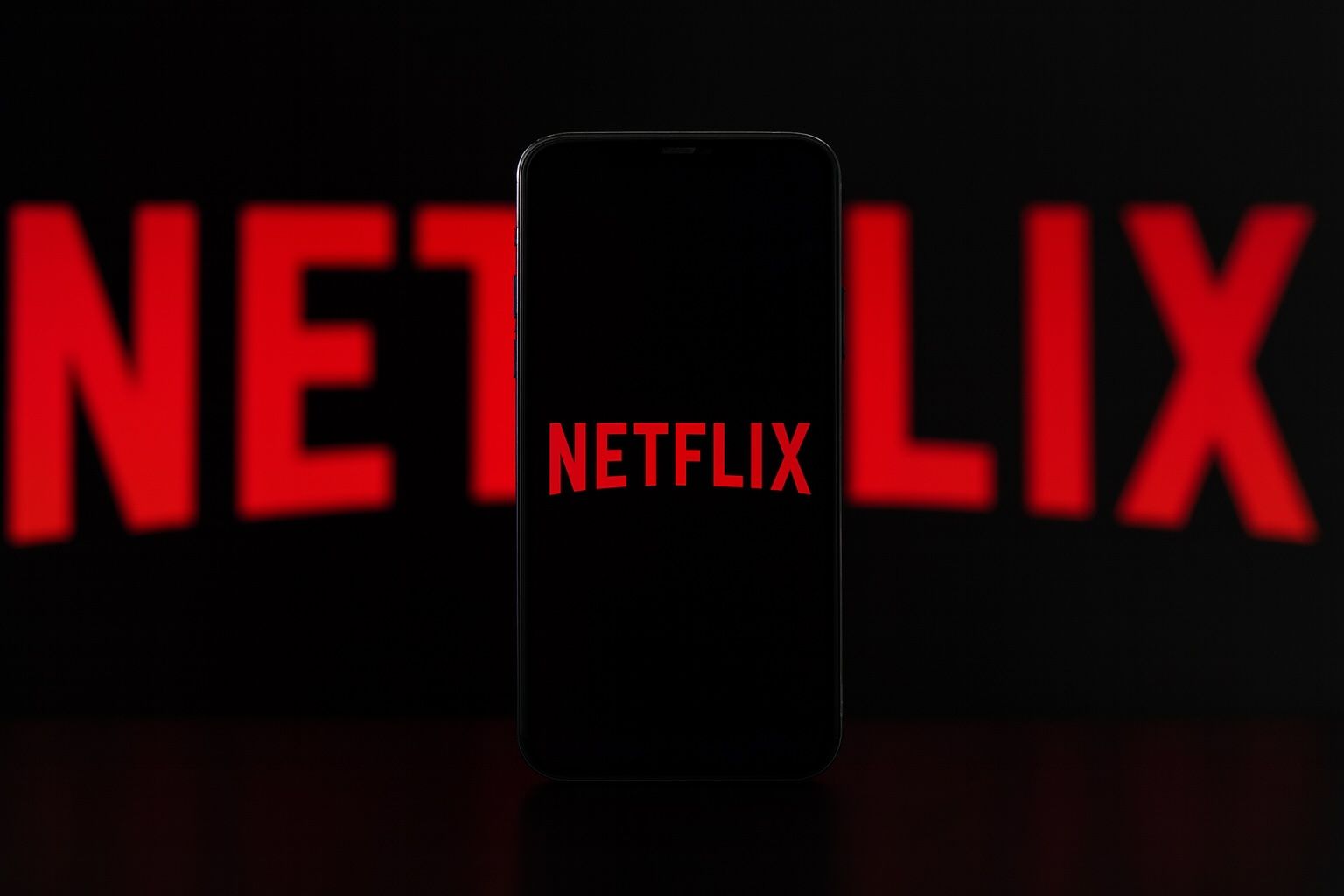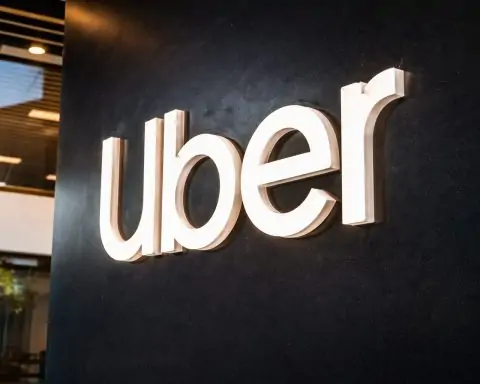- Stock Price: Netflix (NFLX) closed at ~$1,241 on Oct 21, 2025, then opened ~$1,143 on Oct 22 and traded near $1,120 (down ~9–10%) after the Q3 report [1] [2]. YTD, NFLX had soared to all-time highs (mid-Oct ~$1,238) on strong momentum [3].
- Q3 Results: Revenue ~$11.5 billion (+17% YoY) met expectations, but EPS ($5.87) missed forecasts due to a one-time $619 million Brazil tax charge [4]. Netflix reported its “best ad sales quarter” and said it had added ~50 million paid members in 2025 (upgrading guidance) [5]. Full-year revenue guidance (~$44–45 billion) and ~30% operating margin reaffirmed. Q4 guidance was ~$11.96 billion and $5.45 EPS [6], roughly in line with Wall Street’s ~$11.90B/$5.44 estimates.
- Subscribers & Content: Netflix now has about 302 million paid global subscribers [7] (vastly outpacing rivals – Disney+ ~126M; Amazon Prime Video similar [8]). Growth has been fueled by popular releases like K-Pop: Demon Hunters (Netflix’s biggest movie ever) and hit series (Wednesday S2, Stranger Things S4 coming in Q4) [9]. Live events are also on deck (Christmas NFL games, FIFA Women’s World Cup) to attract new viewers and ad dollars [10].
- New Initiatives: The cheaper ad-supported tier (launched late 2022) now has over 94 million monthly users, driving higher margins [11]. Netflix has invested $1 billion+ in video gaming (120+ mobile games), but gaming time remains minimal [12] [13]. The company is also embracing AI: it’s rolling out AI-powered search and interfaces [14] [15], and CEO Sarandos said Netflix is “all in” on generative AI to give creators better tools [16].
- Partnerships: Netflix is expanding beyond video: it will host Spotify’s top video podcasts in early 2026 (e.g. The Dave Chang Show, Bill Simmons Podcast) [17]. It also struck co-marketing deals (e.g. with brewer AB InBev on beer and show tie-ins [18]) to monetize its content off-platform.
- Competition: Netflix remains the clear leader (US share ~20–27%) [19], but rivals are reacting. Disney+ and HBO Max have hiked U.S. subscription prices (Disney+ again in Sept 2025) [20], mirroring Netflix’s prior increases. Amazon Prime Video is adding ads and live sports (NFL, NBA, WWE) to drive profits [21]. Even non-traditional players (YouTube, TikTok) and local services (e.g. Disney+ Hotstar) are targeting Netflix’s turf. Industry analysts note Disney bundling Disney+/Hulu with ESPN (NFL/WWE content) could boost Disney’s revenues [22].
- Analyst View & Forecasts: Most Wall Street analysts remain bullish on NFLX. Roughly 23 of 26 rate it a Buy [23], with 12‑month targets clustering around $1,330–$1,340. Optimistic price targets range $1,375–$1,500 (Bernstein, Evercore, Wedbush), while the most conservative (Goldman) is about $1,300 [24]. After the Q3 miss, some firms lowered targets, but others (Evercore ISI) urged investors to “buy the dip” given that Disney/HBO price hikes give Netflix cover to raise its rates [25].
Stock Performance and Recent Price Action
Netflix stock has been volatile but strong this year. In 2025, NFLX climbed to multi‑year highs – mid‑October it traded around $1,210–$1,240, roughly up 30–40% since January and about +70% from a year ago [26]. The rally was driven by sustained subscriber growth, pricing power and the new ad-supported tier. On Oct 21, NFLX closed at $1,241.35 [27]. After the earnings miss late Oct 21, shares crashed in after‑hours, falling about 5.6% to ~$1,170 [28]. The decline continued on Oct 22: NFLX opened at $1,142.90 [29] and traded as low as ~$1,110 (down ~10%) [30]. By the Oct 22 close (around $1,124), the stock had given back nearly all of its post-earnings gain.
Overall, Netflix’s 2025 run (+39–70% YTD) far outpaced the S&P 500 and peers like Disney. But analysts note the valuation is rich (forward P/E ~50x [31]). Hargreaves Lansdown’s Matt Britzman warned that with “the valuation sitting above its long-term average, there’s added pressure not just to deliver but to exceed” expectations [32].
| Quarter | Revenue (actual vs. est) | EPS (actual vs. est) |
|---|---|---|
| Q3 2025 (reported Oct 21) | $11.50 B vs $11.50 B est [33] | $5.87 vs $6.97 est [34] |
| Q4 2025 (guidance) | $11.96 B vs $11.90 B est [35] | $5.45 vs $5.44 est [36] |
Q3 Earnings and Guidance
On Oct 21 after the U.S. market closed, Netflix beat revenue estimates but missed on profit. Management reported Q3 2025 revenue of about $11.50 billion (+17% YoY), roughly in line with expectations [37]. Net income was $2.50 billion ($5.87 GAAP EPS), below the ~$3.0 billion ($6.97 EPS) analysts had forecast. The shortfall was traced to a one-time $619 million charge related to a Brazil tax dispute [38]. Excluding that, Netflix said operating margin would have topped its 31.5% target. Management described Q3 as having “good momentum” going into year-end [39].
Netflix’s core business is still growing. The company reported its biggest-ever ad sales quarter, and revealed that it has added roughly 50 million net new paid accounts in 2025 (well above its forecasts) [40]. It reaffirmed full-year guidance (~$44–45 B revenue, ~30% operating margin [41]). For Q4 2025, Netflix guided to ~$11.96 B revenue and $5.45 GAAP EPS [42], essentially matching analyst consensus ($11.90 B/$5.44) [43]. CFO Spence Neumann told investors the company is “finishing the year with good momentum” and has “an exciting Q4 slate” of programming [44].
Analysts largely shrugged off the earnings miss as a one-time issue. J.P. Morgan said the $619M charge was “noise,” and noted the quarter still met revenue forecasts [45]. PP Foresight’s Paolo Pescatore called Q3 “another robust quarter, despite a blip due to [the] unforeseen [Brazilian tax] expense” [46]. EMarketer’s Ross Benes pointed out that Netflix’s growth is coming mainly from pricing power: the results “give the impression that the sustained revenue growth achieved this quarter…will predominantly continue to come from subscription fees,” not just adding users [47].
Expert commentary was mixed but leaned positive. Bernstein and Evercore analysts kept bullish stances (12‑month targets $1,375–1,390 [48]), and Evercore ISI advised investors to “buy the dip” given that rivals just raised prices (see below) and Netflix can do the same [49]. On the cautious side, Wedbush’s Michael Pachter warned that Netflix’s gaming expansion has yet to pay off (limited franchise IP) [50]. Zacks Investment Management’s Brian Mulberry noted that new segments (ads, games) “are not profitable [yet],” and “we will certainly want to see that develop” in coming quarters [51].
Subscribers, Content Hits and Pricing Power
Netflix still dominates the streaming market. It now boasts about 302 million paid subscribers worldwide [52] – more than double Disney+ (~126M) and roughly on par with Amazon Prime Video [53]. In the U.S., Netflix’s market share is roughly 20–27%, edging Amazon Prime ahead [54]. Notably, Netflix stopped reporting subscriber counts in early 2025, instead focusing analysts on revenues and profits [55]. That said, the company said it is converting “password sharers” into paid accounts and raising prices, which helped spur subscriber additions. CEO Ted Sarandos highlighted that Netflix’s sustained growth now comes from these moves rather than slowing user gains.
Netflix’s content slate continues to drive engagement. Recent hits include the animated film K-Pop: Demon Hunters (Netflix’s all-time streaming movie record), Wednesday Season 2, and the final seasons of Squid Game and Stranger Things (premiering Q4). Management noted that such hit shows and films have been lifting viewership across markets [56]. Upcoming attractions include The Crown’s last season and new Star Wars series, as well as two live NFL games on Christmas Day – a big draw that also monetizes via the ad tier [57].
All of this gives Netflix pricing power. U.S. subscription fees are already much higher than pre-pandemic, and surveys of homes with multiple Netflix users suggest more customers will accept price hikes. About two-thirds of new sign-ups globally now choose the ad-supported or cheaper tiers, reflecting pent-up demand for lower prices [58] [59]. This trend is strengthening margins: the latest quarter was roughly 28% operating margin and would have hit 31.5% without the Brazil tax hit [60], well above Netflix’s long-term goal (~30%).
Ad Tier, Gaming and AI Initiatives
Netflix’s biggest strategic shift has been diversifying beyond pure subscriptions. The ad-supported tier, launched in late 2022, has taken off: it now has 94+ million monthly active users (about half of new sign-ups) [61]. Ad revenue is expected to nearly double in 2025 as Netflix scales this business [62]. Management is confident ads will “accelerate growth” (a point stressed by Wedbush analysts) but admits the division is still nascent [63] [64]. Zacks’s Mulberry cautioned that ad sales “are not [yet] profitable,” though he noted higher margins and praised the mix shift in general [65].
Netflix has also spent over $1 billion on a video games division, now offering 120+ mobile titles [66]. However, analysts say this has barely moved the needle: after four years the games have boosted viewing time by only ~0.5% (Omdia data) [67]. Wedbush’s Pachter notes Netflix’s games lack iconic IP (unlike Warner Bros/DC), and Omdia’s Rob Gallagher quips games “stand out awkwardly” since Netflix subscribers mainly want a passive, lean-back experience [68] [69]. Netflix leadership acknowledges gaming “is not dissimilar” to past international expansion – long-term payoff but minimal short-term profit [70]. Most executives say the games unit is still far from profitable [71].
On the tech front, Netflix is embracing AI tools. In May 2025 it announced an overhaul of its TV interface and generative-AI search for iOS (users can ask for content in natural language) [72] [73]. This week’s earnings letter reiterated that Netflix is “very well positioned to effectively leverage ongoing advances in AI” [74]. CEO Sarandos said at the Q3 call: “AI can give creatives better tools to enhance their overall TV/movie experience for our members… We’re all in on [AI]… but we’re not chasing novelty for novelty’s sake” [75]. Netflix has already used AI for VFX (e.g. generating a collapsing building scene in The Eternaut) and aging/de-aging in filming [76]. While Hollywood debates AI’s impact on jobs, Netflix sees it mainly as a production accelerator rather than a creative replacement [77].
Partnerships & Diversification
Netflix is widening its entertainment ecosystem. A new deal (announced Oct 14) will bring select Spotify video podcasts (like The Dave Chang Show and Bill Simmons Podcast) onto Netflix’s platform in early 2026 [78]. This adds sports, culture and true-crime video content (e.g. Zach Lowe Show, Serial Killers) beyond Netflix’s originals. In discussion, Netflix’s content VP noted that video podcasts “continue to grow in popularity” and the Spotify tie-up “allows us to bring full video versions of these top shows to both Netflix and Spotify audiences” [79].
Netflix also signed consumer partnerships to monetize its IP. For example, it struck a global co-marketing pact with AB InBev (makers of Budweiser and Corona) that ties Netflix series to beer promotions and sporting events [80]. AB InBev’s marketing chief observed that “streaming is a social and shared experience – it’s an occasion where beer and entertainment come together” [81]. Moves like this help Netflix earn advertising revenue and build brand affinity outside its apps.
Another diversification: Netflix is entering the live events arena. It plans to stream Christmas NFL games and already has deals for a major boxing match and WWE events [82]. These high-profile sports events not only draw viewers but also sell ads on Netflix’s ad-supported tier, leveraging its subscriber base for new revenue.
Competitive Landscape
Netflix still leads the global streaming industry, but competition is intense. Disney+ (126M subs) and Amazon Prime Video (300+ M including Prime buyers) are the closest rivals, but both are aggressive. In September 2025 Disney raised U.S. prices again, and in October HBO Max (Max) raised fees for the second time in 18 months [83]. Warner Bros Discovery’s CEO David Zaslav publicly called HBO “underpriced” and pushed through higher rates [84]. These moves mirror Netflix’s own pricing strategy and underscore an industry shift toward profitability. Analysts say such uniform price hikes give each streamer cover to raise fees. Evercore’s team noted that Netflix has “plenty of cover to boost its own rates” with Disney/HBO jogging prices [85].
Tech and media convergence is also reshaping the field. Disney is bundling Disney+, Hulu and an upcoming ESPN streamer with major sports rights (NFL, WWE) to create an integrated ecosystem [86]. Amazon is doubling down on sports (NFL, NBA, WWE on Prime Video) as a way to drive subscriptions and ad revenue [87]. Even non-traditional competitors loom: YouTube and TikTok continue to attract binge-watchers with shorter-form content.
Meanwhile, Netflix has been mentioned in M&A chatter. Warner Bros Discovery just rebuffed a ~$60 billion takeover bid by Paramount (Oct 21) [88]. In the resulting frenzy, media reports speculated Netflix might be interested in acquiring WBD’s assets (HBO Max, film studios) if a sale goes through [89]. Such a deal could instantaneously boost Netflix’s content library, though it would bring massive debt. For now, Netflix management has not publicly pursued any deal, focusing instead on organic growth.
Analyst Ratings and Outlook
On balance, Wall Street remains bullish on Netflix. Before earnings, many analysts regarded NFLX as “a strong stock to own in 2025” thanks to its large scale and evolving business model [90]. After the mixed report, brokerages reiterated that long-term prospects are solid. About 23 out of 26 tracked firms rate NFLX a Buy [91]. The average 12-month price target is in the $1,330–1,340 range (roughly 10–20% above recent levels) [92]. Aggressive bulls (e.g. Wedbush) have targets up to $1,500 [93], while the most cautious (Goldman) peg fair value near $1,300 [94].
Looking ahead, key questions for Netflix will be whether it can maintain profit margins and subscriber momentum. Management reiterated confidence in hitting ~30% operating margin for 2025. If Netflix delivers on its guidance and continues converting free viewers into paid, analysts say the high valuation is justified [95]. UBS Research even calls Netflix a “secular winner” given its unrivaled scale and global footprint. Conversely, any slowdown in ad revenue growth or unexpected churn could make that 50× forward P/E look excessive. As one analyst put it, Netflix is now a “bellwether” for the streaming era – investors expect a focus on monetization over just eyeballs [96].
Investor Sentiment: Despite the recent pullback, many retail investors appear to remain constructive. Online forums noted that NFLX’s sharp run (30+% YTD) reflects belief in its new growth drivers. They highlight Netflix’s successful “price+ad tier” strategy and content slate as signs that the long-term uptrend will resume. Nonetheless, some caution has crept in – afterglow from the earnings miss saw talk of “buying the dip” while debates swirl about how high subscriber growth can go without reporting counts.
In summary, Netflix’s stock moved sharply on Oct 22 due to a mix of expected (hit content) and unexpected (tax charge, high valuation) factors. The short‑term outlook now hinges on the Q4 schedule (Stranger Things, sports) and sustaining ad‑tier momentum. Long-term, most analysts agree Netflix’s scale and strategy – global expansion, ads, price power and content investment – should keep it on top of streaming. Investors will be watching closely how Netflix navigates competition and executes its ambitious plans to justify that lofty stock price.
Sources: Company filings and earnings, Reuters news reports [97] [98] [99], TS2.tech analysis [100] [101], and statements from industry analysts and executives [102] [103].
References
1. www.reuters.com, 2. www.reuters.com, 3. ts2.tech, 4. ts2.tech, 5. ts2.tech, 6. ts2.tech, 7. ts2.tech, 8. ts2.tech, 9. ts2.tech, 10. ts2.tech, 11. ts2.tech, 12. www.reuters.com, 13. ts2.tech, 14. www.reuters.com, 15. techcrunch.com, 16. techcrunch.com, 17. www.reuters.com, 18. ts2.tech, 19. ts2.tech, 20. ts2.tech, 21. ts2.tech, 22. ts2.tech, 23. ts2.tech, 24. ts2.tech, 25. www.reuters.com, 26. ts2.tech, 27. www.reuters.com, 28. ts2.tech, 29. www.reuters.com, 30. www.reuters.com, 31. ts2.tech, 32. www.reuters.com, 33. ts2.tech, 34. ts2.tech, 35. ts2.tech, 36. ts2.tech, 37. ts2.tech, 38. ts2.tech, 39. ts2.tech, 40. ts2.tech, 41. ts2.tech, 42. ts2.tech, 43. ts2.tech, 44. ts2.tech, 45. www.reuters.com, 46. ts2.tech, 47. ts2.tech, 48. ts2.tech, 49. www.reuters.com, 50. ts2.tech, 51. ts2.tech, 52. ts2.tech, 53. ts2.tech, 54. ts2.tech, 55. www.reuters.com, 56. ts2.tech, 57. ts2.tech, 58. www.nasdaq.com, 59. www.reuters.com, 60. ts2.tech, 61. ts2.tech, 62. ts2.tech, 63. ts2.tech, 64. ts2.tech, 65. ts2.tech, 66. ts2.tech, 67. www.reuters.com, 68. www.reuters.com, 69. ts2.tech, 70. www.reuters.com, 71. ts2.tech, 72. www.reuters.com, 73. www.reuters.com, 74. techcrunch.com, 75. techcrunch.com, 76. techcrunch.com, 77. techcrunch.com, 78. www.reuters.com, 79. www.reuters.com, 80. ts2.tech, 81. ts2.tech, 82. ts2.tech, 83. ts2.tech, 84. ts2.tech, 85. www.reuters.com, 86. ts2.tech, 87. ts2.tech, 88. ts2.tech, 89. ts2.tech, 90. ts2.tech, 91. ts2.tech, 92. ts2.tech, 93. ts2.tech, 94. ts2.tech, 95. ts2.tech, 96. ts2.tech, 97. ts2.tech, 98. www.reuters.com, 99. www.reuters.com, 100. ts2.tech, 101. ts2.tech, 102. techcrunch.com, 103. ts2.tech








